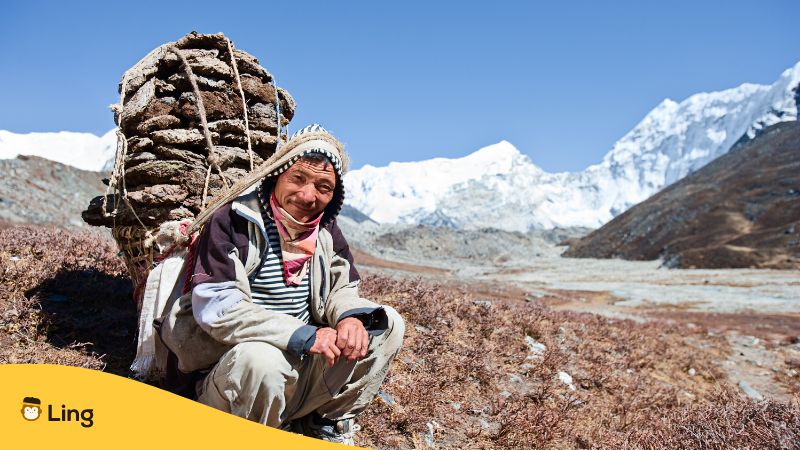In language, prepositions are always used – even without recognizing them! Many English prepositions can be found just in a single sentence. What about in Nepali? Let’s check out some Nepali prepositions today.
The Nepali language is unique and special in many ways. Prepositions are known as पूर्वसर्ग Pūrvasarga. This is defined as a word that modifies a noun or a pronoun by usually coming before it. In the English language, they can be a group of words too that link nouns, pronouns, and phrases to other words in a sentence.
In Nepali grammar, prepositions have something special. It is called postpositions. Most often the suffix -maa or -मा which means to, in, or at is used and they are postpositions because they are placed after the word. Let’s look at some examples in sentences.
| English | Nepali | Pronunciation |
| There is a pen in my bag. | मेरो झोलामा कलम छ । | Mero cholama kalam cha. |
| Tea is on the table. | टेबलमा चिया छ। | Tebalama chiya cha. |
| She is at my house. | उनि मेरो घरमा छिन् | Uni mero gharma chin. |
The Nepali prepositions join as a suffix with the noun.
Understanding Nepali Prepositions
The language has complex grammar and syntax. It is a highly inflected language, meaning that there are many different forms of a single word. This can make it difficult to identify the correct preposition for a given context. Some words may not always be listed in a standard Nepali dictionary.
To understand Nepali prepositions, here are some examples:
- in the middle – बिचमा bichama: Middle is “bicha” and in is “ma”. In the Nepali language, the “in” comes later and the middle comes first. “In” is made into a suffix.
- for – को लागी Ko Lagi: It is two words because “ko” joins with the subject.
- After पछि Pachi and before पहिले Bahile: These can be used normally with nouns but when used with verbs, they are shortened and made into a suffix that joins the verb.
List Of Nepali Prepositions

For best practice, let’s take a look at several prepositions.
| English | Nepali | Pronunciation |
| About | लगभग | Lagabhaga |
| Above | माथि | Mathi |
| Across | पार | Para |
| After | पछि | Pachi |
| Against | विरुद्ध | Viruddha |
| Along | साथ | Satha |
| Among | बीचमा | Bicama |
| Around | वरपर | Varapara |
| At | मा | Ma |
| Before | पहिले | Bahile |
| Behind | पछाडि | Pachadi |
| Below | तल | Tala |
| Beneath | तल | Tala |
| Beside | छेउमा | Cheuma |
| Between | बीचमा | Bicama |
| Beyond | परे | Pare |
| But | तर | Tara |
| By | द्वारा | Dvara |
| Despite | बावजुद | Bavajuda |
| Down | तल | Tala |
| During | समयमा | Samayama |
| Except | बाहेक | Baheka |
| For | को लागी | Ko Lagi |
| From | बाट | Bata |
| In | मा | Ma |
| Inside | भित्र | Bhitara |
| Into | मा | Ma |
| Like | जस्तै | Jastai |
| Near | नजिक | Najika |
| Of | को | Ko |
| Off | बन्द | Banda |
| On | मा | Ma |
| Onto | मा | Ma |
| Out | बाहिर | Bahira |
| Outside | बाहिर | Bahira |
| Over | माथि | Mathi |
| Since | देखि | Dekhi |
| Through | मार्फत | Marphata |
| To | को | Ko |
| Toward | तर्फ | Tarpha |
| Under | अन्तर्गत | Antargata |
| Until | सम्म | Sam’ma |
| Up | माथि | Mathi |
| Upon | माथि | Mathi |
| With | संग | Sanga |
| Within | भित्र | Bhitra |
| Without | बिना | Bina |
Nepali Prepositions In Sentences And Phrases

With the understanding of the prepositions mentioned earlier, take a look at the sentences below:
| English | Nepali | Pronunciation |
| He sat on the chair. | उ कुर्सीमा बस्यो । | U kursima basyo. |
| There is some milk in the fridge. | फ्रिजमा केही दूध छ। | Phrijamā kēhī dūdha cha. |
| She was hiding under the table. | उनी टेबुलमुनि लुकेर बसेकी थिइन् । | Unī ṭēbulamuni lukēra basēkī thi’in. |
| The cat jumped off the tree. | बिरालो रुखबाट हाम फाल्यो । | Birālō rukhabāṭa hāma phālyō. |
| I lost my phone in the hotel. | होटलमा मेरो फोन हरायो | Hōṭalamā mērō phōna harāyō. |
| They will need to go at noon. | तिनीहरू दिउँसो जानु पर्छ। | Tinīharū di’um̐sō jānu parcha. |
| The book belongs to the school. | पुस्तक विद्यालयको हो । | Pustaka vidyālayakō hō. |
| They were sitting by the tree. | तिनीहरू रूखको छेउमा बसिरहेका थिए। | Tinīharū rūkhakō chē’umā basirahēkā thi’ē. |
Practice these sentences. Try also using a Nepali dictionary to change some of the sentences.
Wrapping Up!
Nepali is a unique and special language in many ways. It is the official language of Nepal and is spoken by over 17 million people. It also has its own distinct grammar and vocabulary, which make it stand out from other languages of the region. It is considered a very poetic language and its literature is known for its beauty and depth.
Nepalis are known for their fun-loving nature and sense of humor. A common joke amongst Nepali people is that the only thing that separates Nepal from India is the Himalayas. But when it comes to Nepali prepositions, it is challenging to learn without practice.
This article has mainly served as a guideline to understand Nepali prepositions. But if you are planning to travel, Nepal is an affordable destination to explore, with budget travelers able to find comfortable lodgings and meals.
Learn Nepali With The Ling App

To make your trip fun-filled and entertaining, engage yourself in absorbing a lot of Nepali language. How? Try out the Ling App!
The Ling App is a great tool for learning Nepali. It provides users with a range of features to help them learn the language. It has a variety of interactive lessons that cover all the basics of the language, including grammar, vocabulary, and pronunciation. It also has a voice recognition feature that allows users to practice their pronunciation and get instant feedback from native speakers.
It also offers gamified quizzes, engaging exercises, and great flashcards to help users test their knowledge and recall information. The Ling App also provides users with detailed progress tracking so they can keep track of their progress as they learn Nepali.
Learning a new language has never been easier. Find us on the Apple Store or Google Play Store to download the Ling App today!





























































